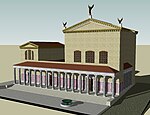Curia Hostilia

The Curia Hostilia was one of the original senate houses or "curiae" of the Roman Republic. It was believed to have begun as a temple where the warring tribes laid down their arms during the reign of Romulus (r. c. 771–717 BC). During the early monarchy, the temple was used by senators acting as a council to the king. Tullus Hostilius (r. 673–641 BC) was believed to have replaced the original structure after fire destroyed the converted temple. It may have held historic significance as the location of an Etruscan mundus and altar. The Lapis Niger, a series of large black marble slabs, was placed over the altar (known as the Volcanal) where a series of monuments was found opposite the Rostra. This curia was enlarged in 80 BC by Lucius Cornelius Sulla during his renovations of the comitium. That building burned down in 52 BC when the supporters of the murdered Publius Clodius Pulcher used it as a pyre to cremate his body.
Excerpt from the Wikipedia article Curia Hostilia (License: CC BY-SA 3.0, Authors, Images).Curia Hostilia
Argiletum, Rome Municipio Roma I
Geographical coordinates (GPS) Address Nearby Places Show on map
Geographical coordinates (GPS)
| Latitude | Longitude |
|---|---|
| N 41.893055555556 ° | E 12.485277777778 ° |
Address
Curia Iulia
Argiletum
00184 Rome, Municipio Roma I
Lazio, Italy
Open on Google Maps








